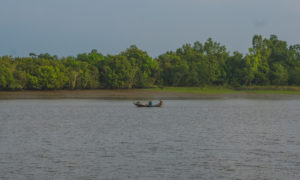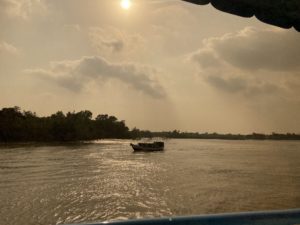How BECA is Working With Local Communities
Published: 30 May 2022
For this blog, intern Deanna Elliott had the opportunity to speak with Solimar International’s Director of Social Enterprise, Matt Humke, about their new USAID-funded project focused on tourism and conservation in Bangladesh: the Bangladesh Ecotourism and Conservation Alliance (BECA). How is BECA working with local communities conserve the Sundarbans Reserve Forest and improve their livelihoods? Read on to find out!
The Sundarbans and BECA
The Sundarbans Reserve Forest is a protected area containing the largest mangrove ecosystem on Earth, stretching out over 3,900 square miles (10,000 km2). It is a binational wetland with ⅔ of its area residing in the southwest of Bangladesh and the remaining ⅓ in India. The forest plays an important role in the livelihoods of the 76 surrounding Bangladeshi communities. It provides food, economically vital fisheries, and other natural resources, and is the last home of the Bengal tiger. It is a lovely habitat and provides a multitude of ecosystem services, but it is also incredibly fragile. In recent years, climate change, resource extraction, and human-wildlife conflict have threatened the stability and biodiversity of the Sundarbans. Unsustainable tourism practices have also played a role in this degradation, which is what BECA aims to change.

The Sundarbans Reserve Forest encompasses the largest remaining mangrove habitat in the world.
Solimar International and USAID have partnered in the Bangladesh Ecotourism and Conservation Alliance to develop a sustainable tourism strategy that will improve both conservation efforts and community well-being in and around the Sundarbans.
Interview Highlight: Matt Humke
In the last two decades, Matthew Humke, Solimar International’s Director of Social Enterprise, has worked to develop sustainable tourism as a tool for biodiversity conservation and poverty alleviation throughout the developing world. The success of community-based tourism operations he has established in Latin America, Asia, and Africa have earned him multiple accolades, including the World Travel & Tourism Council’s “Tourism for Tomorrow” award and a spot on Condé Nast Traveler’s “Green List.” His high-end trekking company, Trek Guatemala, was included on National Geographic Adventure’s “Best Adventure Travel Companies on Earth.”
Matt has used his expertise in tourism operation, product development, marketing, and destination management to publish the Sustainable Tourism Toolkit, designed to assist local businesses in building successful sustainable tourism operations. He is also an instructor in George Washington University’s Master in Tourism Administration program.
A Visit To The Sundarbans
Recently, Matt had the opportunity to join Solimar CEO Chris Seek on a trip to visit the Sundarbans and speak with local stakeholders.
Impressions of Bangladesh and Tourism in the Sundarbans
When I ask Matt for his impression of Bangladesh, he says, “Fascinating. But overwhelming.” Bangladesh is the most densely populated country in the world–170 million people in a place the size of Florida. Getting out into the Sundarbans, I’m told, is just the opposite. “It’s pristine and calm, despite urban and agricultural growth pushing up against the forest’s border. For many Bangladeshis, visiting the forest might be their first time in true solitude, their first time interacting with nature.”
This leads to a surprising revelation: Tourism is already a well-established industry in Bangladesh, and 99% of Sundarban Reserve Forest visitors are Bangladeshi citizens. Much of the time, Solimar’s focus is on bringing international tourists into a destination; here, the linchpin is increasing domestic tourism and, with that, raising awareness of the importance of the forest’s conservation.

A trip to the forest may be a Bangladeshi’s first encounter with wild nature.
Obstacles to Conservation
Currently, Matt says, most visitors to the forest come from the capital, Dhaka–and they don’t necessarily get their money’s worth on tours. “The tours now aren’t educational or interpretive, visitors don’t learn about the history or culture of the Sundarbans or why it should be conserved.” This lack of knowledge is the main impediment to bringing conservation into the national conversation.
How Tourism Can Help Conservation
Matt tells me that domestic tourism in Bangladesh is the key to making gains in conservation. “The general population of Bangladesh are the ones who vote politicians into office, support social media campaigns, advocate for what they want.” And they can’t want to preserve the Sundarbans if they don’t understand its significance. So how can we help the Bangladeshi people to recognize the value of the forest beyond resource extraction? By improving not only the quality of content on tours, but also the sustainability of the tours themselves. This is where BECA comes in.
How Solimar Is Helping the Sundarbans
Tourism is an entrenched industry in the Sundarbans, but the visitor experience needs to be enhanced.
Boat Tours
The most popular tours are single-day boat rides and “liveaboard” cruises, which let guests spend three days and two nights in the forest. However, the bulk of these tours are spent watching the mangrove trees go by, and occasionally seeing wildlife. These liveaboard boat operations have the time and opportunity to truly educate guests, and so these are the tours BECA is targeting.
Matt makes the point that travel these days is all about the experience–people want to get their hands dirty and immerse themselves in local culture. Solimar’s first order of business, then, is to train local residents around the Sundarbans to be guides. Instruction in the history of the forest and interpretation of the value it holds, interwoven with stories of daily life in the Sundarbans, Matt tells me, will capture guests’ attention far better than facts and figures; storytelling makes for a more compelling call to action than dry data.
Additionally, 20 or more locals can earn a living from working as guides. The forest interior is a dangerous place to work; fishers, honey collectors, and nypa palm gatherers need to be constantly on alert for tigers. Approximately 10–15 people a year are killed by Bengal tigers in the forest–any opportunity for alternate work could save lives.
Sustainability Certification
Additionally, Solimar is creating a sustainability eco-certification for boat tour operators. This will incorporate things like greener operation of boats and environmental education for boat tour staff. Participation in this certification will help operators practice what they will be preaching, and demonstrate to visitors their care for the Sundarbans. It’s also, Matt banters, just good business strategy! Reductions in energy and water use, as well as single-use items, save money.

Creating sustainable and educational boat tours can contribute to national conservation efforts.
Community Involvement
Along with guides, Solimar hopes to train others in local villages interested in community-based tourism work. Activities like food service, sales of local crafts, and managing tourist houses grant an even greater possibility for economic growth. In the Sundarbans, Matt visited three communities and engaged with a variety of cultural activities, including music, food, and plays of local stories. He says this inspired an idea to run cultural festivals in villages for visitors to step off the boats and participate in.

Teaching locals to participate in tourism activities and marketing grants opportunities for economic growth.
Management and Marketing
Solimar’s goal is to fold these activities and certifications into a DMO, or a Destination Management Organization. DMOs organize tourism at the local level, and assist with marketing and business support. The main activity for DMO-building in Bangladesh was Matt and Chris’ workshop with the Tourism Operators Association of the Sundarbans (TOAS). The purpose was to introduce these concepts–training locals, eco-certifications, interpretive and hands-on tours–to the people who operate boat tours. Matt tells me that he wasn’t sure what the outcome would be, if anyone would take offense to Solimar’s updates to established strategies, but “the response was overwhelmingly positive; they loved our ideas.”
They also loved the other side of the DMO’s activities: marketing. Solimar will train tourism operators and staff in creating and managing effective online content, such as a destination website that lists all TOAS information in one place. Not only that, businesses will receive guidance in branding and product development. According to Matt, the private sector is vital to a project’s success– if Solimar only worked with isolated communities, tourism would be difficult to develop. Private sector operators can provide infrastructure to and connect visitors with these destinations. In return, the DMO promotes their companies. Seems like a win all around to me.
Solimar International and USAID’s Bangladesh project will run through October 2024, having hopefully built a lasting and effective sustainable tourism industry.
My thanks to Matt Humke for indulging my questions about a place I hope to travel to one day.
Liked learning about sustainable tourism development and want to hear more? Take one of our courses to learn more about DMO development. Visit our Institute for Sustainable Destinations website today: https://institute.solimarinternational.com/
